For my second grouping of permaculture plants that I think are quintessential for improved self-reliance, I’m thinking somewhat outside-the-box. Rather than focus specifically on plants that people will want to harvest from directly, I’ve picked plants that humans and animals both distinctly benefit from.
A perennial plant that can be harvested by an animal is really cool because once you plant (and sometimes, additionally, protect) there is effectively zero maintenance required. It’s the set-it-and-forget-it of the gardening world. With harvesting on auto-pilot, there’s some real freedom.
Obviously, eventually you’ll want to be harvesting something, whether that’s chickens, eggs, venison, beef, pork, etc. I’ll note the animal benefit as well as the human benefit on all these plants.
Permaculture Plant #1: Mulberry
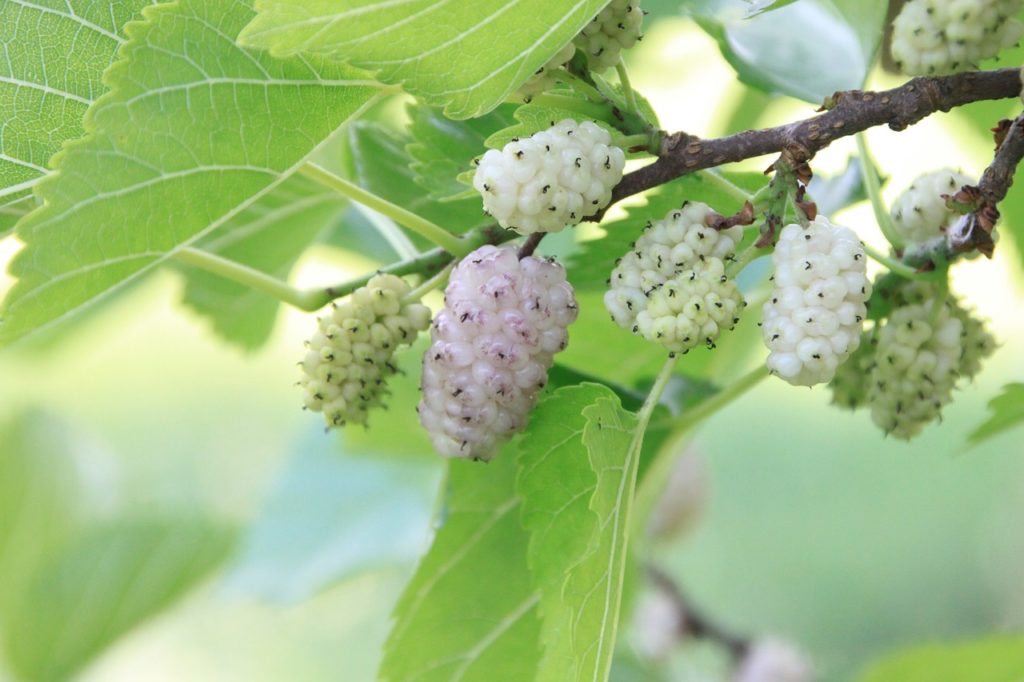
Elevator Pitch: This is the easiest to grow fruit tree in existence as far as I’m concerned, and the berries taste like almost pure sugar. They’re easy to propagate from cuttings, they grow fast, and their wood is very hard, which could be useful if you want firewood. They’ll grow in nearly any situation and rain down pounds and pounds of fruit during the early summer.
Human benefits: Human-edible fruit, high in sugar with a fairly mild flavor profile. I think they’re great with something tart (like rhubarb, currants, or elderberries) in a pie or other dessert dish.
Animal benefits: The leaves of mulberry trees are particularly high in protein, and highly desirable to animals like deer (watch that video, it’s less than a minute and it’s really cool.) or any herbivorous grazer (horse, cow, goat, sheep, etc.) You can collect and dry the branches to make leaf hay, which the mulberry is well suited for because of it’s ability to regrow after coppice or pollarding. You can cut a sizable tree right to the ground and it’ll happily resprout the following season.
Obviously, animals like the fruit too. Deer, turkey, pigs, chickens, and more will gladly eat the fruit that the tree has dropped. It’s a great early summer crop, one of the first to fruit. This helps both domestic and wild animals replenish the depleted stores of fat lost during the winter months.
Planting notes: My #1 piece of advice with mulberries is do not plant this where people regularly walk. Mulberries drop an obscene amount of berries for a good portion of the summer, and if you plant one over your deck or porch or sidewalk, you’ll be tracking berry juice into your house all the time. It’s very annoying, ask me how I know.
Generally, I’d advise you to plant this in the following locations:
- Chicken yard – will need some initial protection, but will eventually provide tons of shade and free food. The chickens will love it.
- Hunting food plot – Plant this at or near your food plot but remember that this will attract wild game during the summer months. It’s a great way to get the wildlife accustomed to coming to an area. It is not a complete solution for a perennial food plot tree, because it does nothing to attract deer to your plot during the hunting season. It is a great start though. You’ll need to protect young mulberries until they’re about 5ft tall or deer will mow them to the ground.
- Between paddocks for pastured animals – The fruit will be a great supplement for grazing animals, and an excellent calorie source for omnivorous livestock.
Permaculture Plant #2: Thornless Honey Locust
Elevator Pitch: Because of the dappled shade it casts, honey locust is ideal for a shade tree for pasture animals. The dappled shade provides respite for the animals, but still allows plenty enough sunlight through to grow the grass underneath. Additionally, the sugar-rich pods (pictured to the left) are useful as stored winter feed, or the animals will just eat the pods when they drop in the late fall, building up fat reserves for insulation and calories.
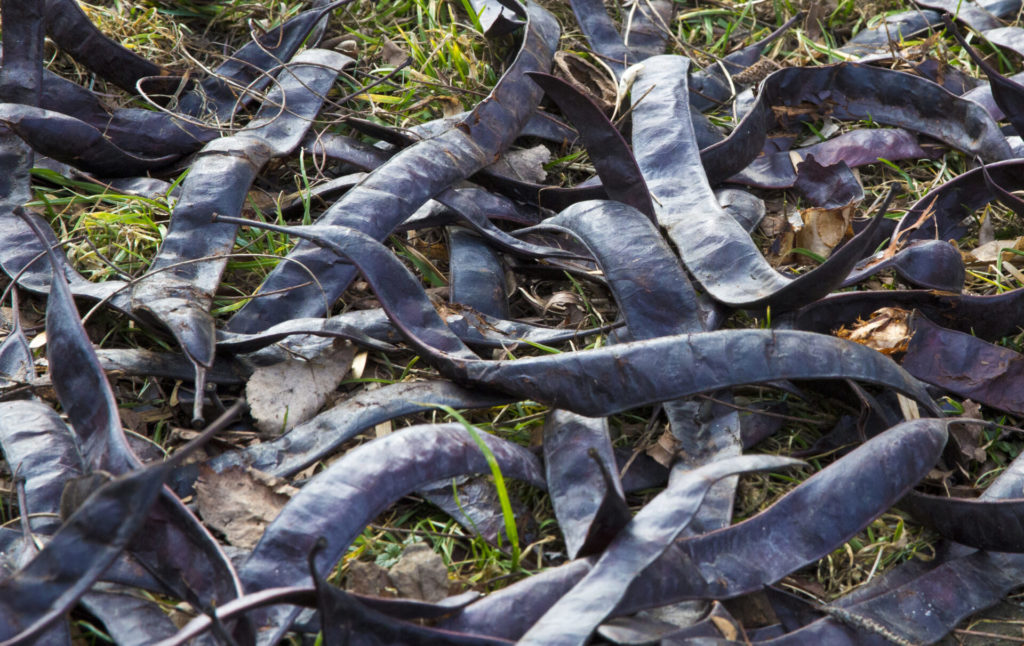
I’m not affiliated with coldstream, but I’ve purchased trees from them before and I was satisfied with those trees.
Human benefit: Shade tree, coppice firewood, sweet pods contain a syrup reminiscent of honey that you can process into a sweetener. Easy to grow from seed.
Animal benefit: Shade tree, late fall/winter food store. Attracts deer during late fall, possibly some overlap with hunting season. Loved by horses.
Planting notes: I highly recommend checking out the YouTube channel Trees for Graziers for notes on planting this tree, and there is a book by the same name. The book has loads of valuable info for calculating where and how many trees to plant. This tree can radically reduce winter feed costs for grazing animals. If you have those or want those, picking that book up will be worth it for you.
I’d also use this tree as a food plot centerpiece, it’ll give the deer some sugar to help them survive the winter, and attract deer to your food plot during the late fall. There’s one more tree I consider essential to a complete perennial tree-based food plot system–that’s just a bit further down the list.
Permaculture Plant #3: Sunchoke/Jerusalem Artichoke
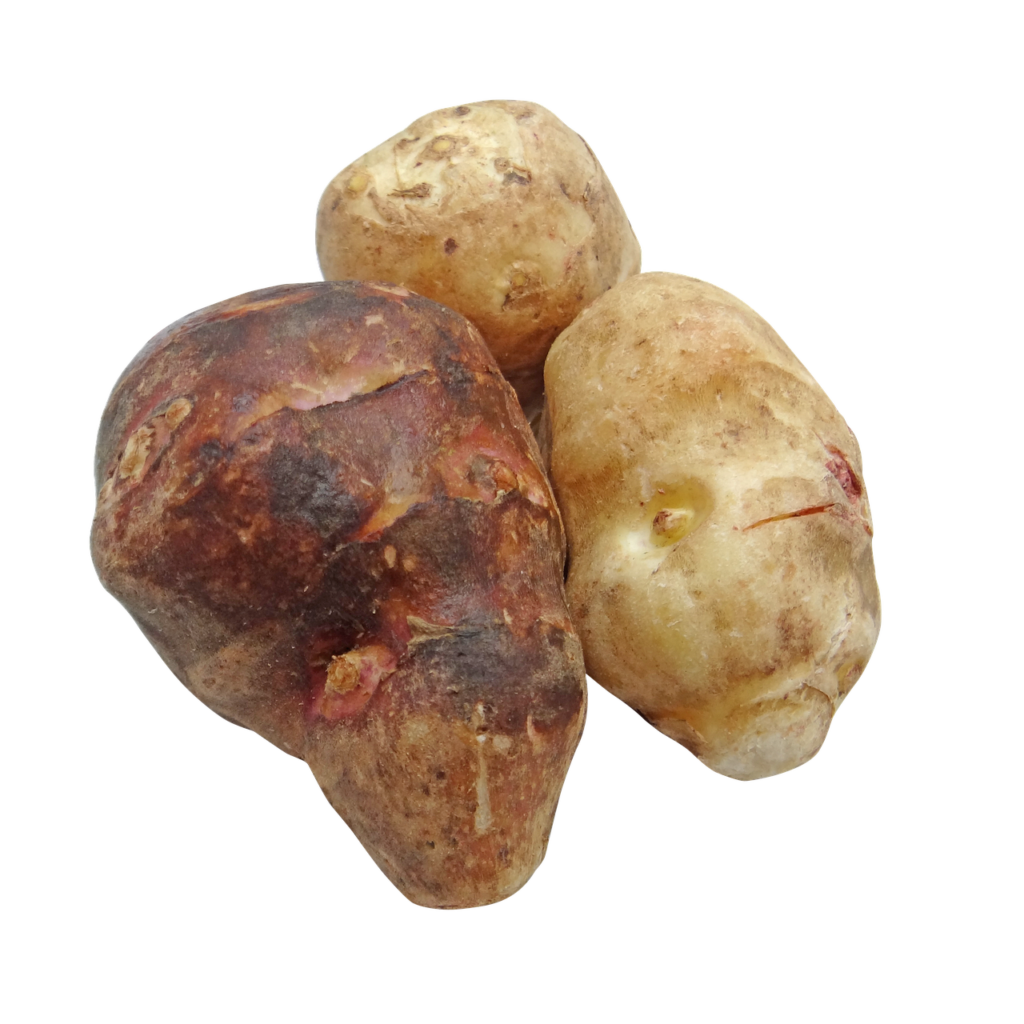

Elevator Pitch: Perennial potato-like root vegetable that grow beautiful flowers. Good for people or pigs, depending on how much of the harvest work you want to do.
Human benefit: Jerusalem artichokes are edible raw, or cooked like potatoes. They come back every year even when harvested heavily. They produce a great deal of green biomass for composting, salad for chickens, or chop and drop mulch.
Animal benefit: Rooting animals like pigs would be in heaven digging up these tubers. That saves you some back-breaking harvest work!
Planting Notes: Sunchokes got that name for a reason–they’re an aggressive plant that can easily take over an area. Don’t plant these right next to your veggie garden. Other than that, these powerful plants go just about anywhere. They’d do well at the border of a forest and a lawn. They won’t travel into the forest because of the shade, and they won’t travel into the lawn because of the mower.
Permaculture Plant #4: Chestnuts
Elevator pitch: Corn doesn’t grow on trees, but chestnuts do and they’re almost nutritionally identical. Additionally, although many hunters think that acorns are the best hard mast species for deer, research suggests that deer will choose chestnuts over acorns 100 to 1. Without using a nutcracker, try eating one of each and you’ll quickly see why.
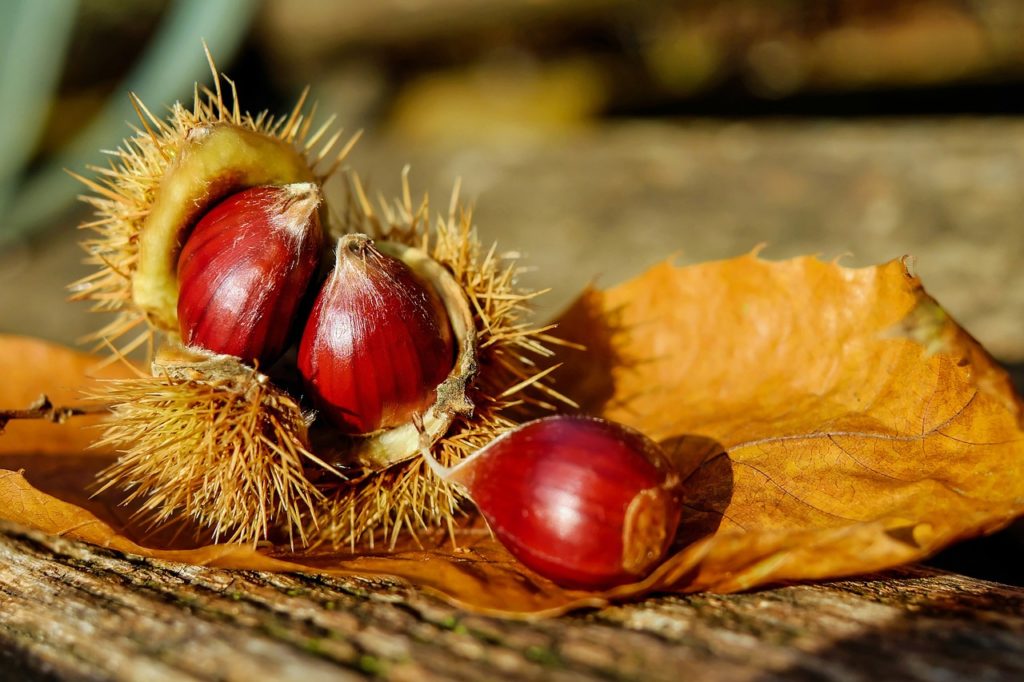
Human benefit: Chestnuts roasting over an open fire.
Animal benefit: Venison roasting over an open fire. Or pork. Or chicken. Might have to process the nuts a bit to feed them to chickens, but I don’t think it’d take much beyond mashing them a bit so the meat of the chestnut opens up–the chickens will take it from there. Pigs and deer will just eat the dang things whole.
Planting notes: I’ll be writing an entire article about my current theory for perennial planting for deer. Deer eat 5 times a day, and prefer “hard mast” like nuts during the night, and “soft mast” like grass, fruit, clover, and leaves during the day. For that reason I generally would prefer to plant chestnut trees in and around bedding areas, but they’re also useful on the edges of food plots. Don’t plant them where people walk, because the spiny burs are not fun to step on.
Permaculture Plant #5: Chinquapin (they’re baby chestnuts)
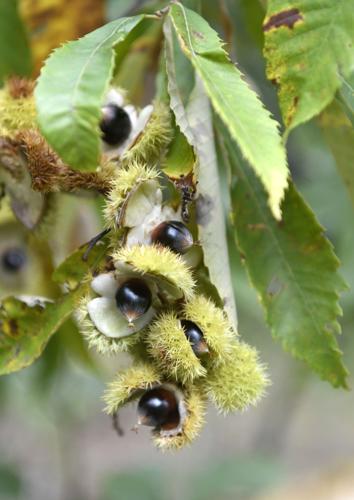
-Joshua David Curry, 2023
Source: https://www.bdtonline.com/gallery/slideshow-chinquapin-picking/collection_e12c9dfe-f9f6-11ea-a1dd-339479f17c47.html#6
Elevator Pitch: A very cold hardy subspecies of chestnut that produces tiny chestnuts. Not really much good for people, but fantastic for turkey that might struggle to get their gobble on the much larger Chinese chestnuts.
Human benefit: If you’re in the woods, eating these tiny little guys will be marginally preferable to starvation.
Animal benefit: These are just “fun size” chestnuts. Animals have all day to eat stuff, they don’t have jobs, so they don’t mind taking their time to eat chinquapins.
Planting notes: See above for chestnut planting notes.
Permaculture Plant #6: Siberian Pea Shrub
Elevator Pitch: Grow-in-place chicken feed that has beautiful flowers during the summer.
Human benefit: The very young pods have edible seeds inside that taste a bit like peas or lima beans, but become very hard at maturity. Adds visual beauty to chicken yards.
Animal benefit: The seeds are as much as 36% protein, so they make an excellent supplemental feed for pigs or chickens. May require some milling so that animals can digest them optimally.

Planting notes: SPS is a nitrogen fixer, so it’s friendly to other nearby permaculture plants. It makes an excellent hedgerow. The plant does have some thorns, not nasty ones though. It’s a good candidate for planting in a chicken yard, with some protection.
Permaculture Plant #7: American Persimmon
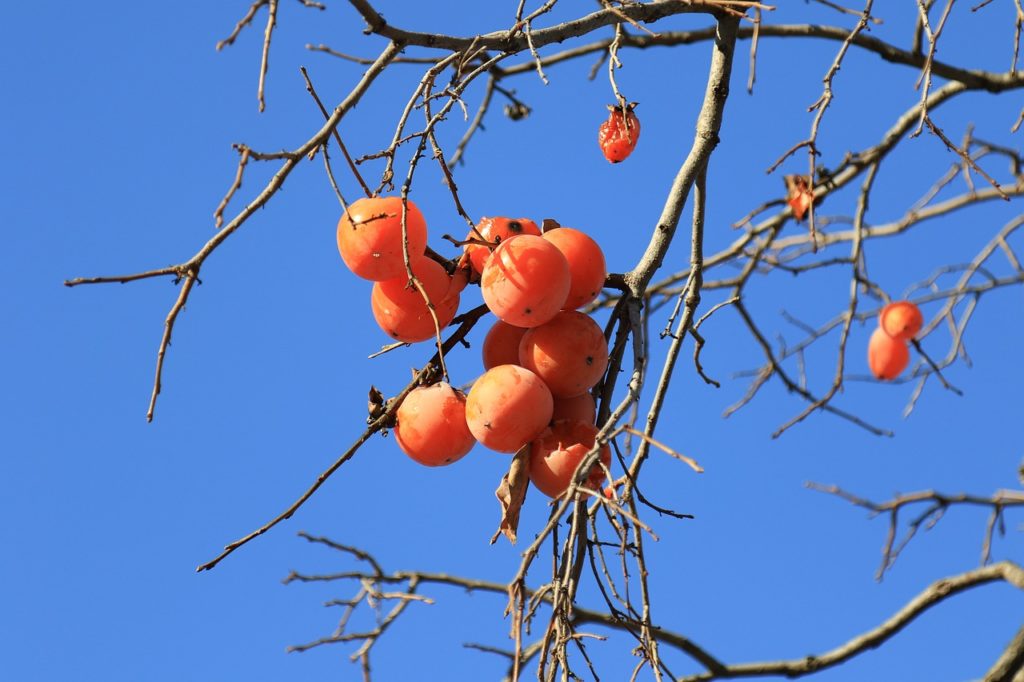
Elevator Pitch: This is a fruit that starts dropping around November, when every other fruit tree has been asleep for almost a month. This makes it valuable not just for people, but tremendously valuable for whitetail deer, and people inclined toward eating the whitetail deer that these trees can attract to your food plots.
Human benefits: Very late season fruit crop. The fruit is absolutely magically delicious, like tangerine caramel pudding. They have a texture kind of like a soft fig. It’s a little odd the first time you try it, but I’ll never go back. I’m a persimmon aficionado for life.
Animal benefits: My primary interest in this tree is as a deer attractant because of the timeliness of the fruit drop. Because it drops during hunting season, it’s the perfect tree to plant right near your tree stand or blind. Plant a few of them, and you’ll have deer flocking to you right where and when you want them to be. Additionally, pigs, chickens, goats, sheep, and cows relish this sugary treat.
Planting notes: Say it with me now: “Don’t plant this tree where people walk!” Because of the heavy late-fall/winter fruit drop, this tree makes a big mess. Leave it out in pastures, food plots, or parts of the land with low foot traffic.
Conclusion
Have any questions about these permaculture plants? I’d love to try to answer them, maybe we’ll both grow our knowledge!
Leave a Reply